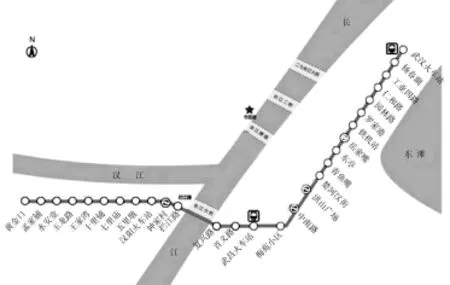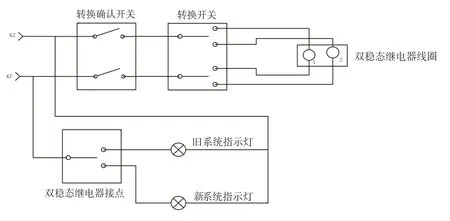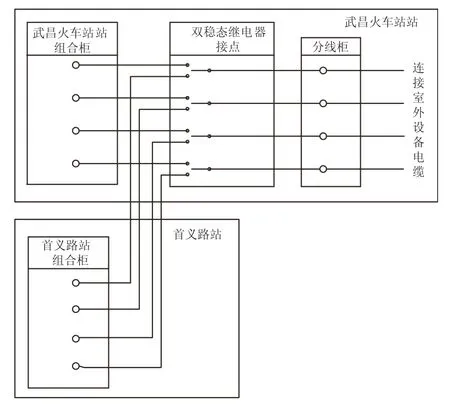城市轨道交通信号系统倒切电路设计
2017-08-01刘莉胡姗
刘莉胡姗
城市轨道交通信号系统倒切电路设计
刘莉胡姗
(武汉地铁运营有限公司,430061,武汉//第一作者,工程师)
城市轨道交通既有系统和新设系统的贯通与调试不能影响到既有信号系统的正常运营。针对调试期间室外设备运营时段由既有信号系统控制、非运营时段由新设信号系统控制产生的分时复用问题,介绍了一种利用双稳态继电器进行新旧系统切换的倒切电路。该倒切电路通过采用满足SIL 4安全级别的双稳态继电器实现室内新、旧系统对室外设备的分时控制,以及赋予不同人员的操作权限,从管理和技术两方面确保电路的安全性。在实际案例应用中,该倒切电路表现出操作简洁、安全性高、显示清晰等优点。
城市轨道交通;信号系统;倒切电路;轨旁设备;分时复用
Author′s addressWuhan Metro Operation Co.,Ltd.,430061,Wuhan,China
我国各个城市规模不同,导致规划的城市轨道交通线路长短不一。为减少城市轨道交通建设对市民出行的影响,部分城市针对长线路的处理方法是将一条长线路划分为若干子线路进行分期开通。一旦线路分期开通,就会面临先期开通工程和后期开通工程的线路贯通及系统贯通问题。
武汉地铁4号线一期工程自武汉火车站站至武昌火车站站,2013年12月开通运营,共设信号设备集中站6座;二期工程自武昌火车站站至黄金口站,2014年12月开通运营,共设信号设备集中站5座。武昌火车站站为4号线一、二期工程的衔接站。武汉地铁4号线线路图如图1所示。

图1 武汉地铁4号线线路图
在4号线一期线路信号系统中,将武昌火车站站设置为信号联锁集中站,其控制区域为武昌火车站站和梅苑小区站;当一、二期线路贯通后,武昌火车站站作为信号设备非集中站,其室内的集中站信号设备被拆除,武昌火车站站和梅苑小区站室外的信号设备由首义路集中站进行控制。在一、二期线路贯通调试期间,调试时段原一期线路武昌火车站站控制区的室外设备如转辙机、信号机、计轴等由首义路控制区进行控制,而运营时段这些室外设备由武昌火车站集中站进行控制,因此武昌火车站站和梅苑小区站的室外设备面临不同时段由2个集中站分别进行控制的情况。调试期间室外信号设备在2个不同的集中站之间频繁倒切,涉及到倒切的快速性及可靠性问题。常见的信号系统倒切方式为:调试前,人工在原有系统分线盘上将室外设备的室外电缆断开,然后将室外设备的电缆接入新系统的分线盘,实现新系统对室外设备的控制;调试结束后,将室外线缆接回既有分线盘恢复与原系统的连接。该倒切方式存在倒切速度慢、容易出错、效率低下等缺点。本文介绍一种快速、便捷、准确率较高的倒切方式,其在武汉地铁4号线一期工程和二期工程的贯通调试中获得了较好的倒切效果。
1 转极电路及表示电路的设计
双稳态继电器具有2个稳定的状态,切断继电器励磁电路的电源,继电器接点的状态不会改变。双稳态继电器分为单线圈和双线圈双种,本文案例中采用双线圈双稳态继电器。在双线圈双稳态继电器中,当给一个线圈供电时,继电器处于导通状态,当给另一个线圈供电时,继电器返回到断开状态。
在倒切电路中设计了新、旧信号系统转换确认开关和转换开关。转换确认开关和转换开关的工作原理图如图2所示。其中,转换确认开关用于确认是否需要转换,转换开关用于选择双稳态继电器的供电线圈。当设备需要转换时,转换确认开关拧至确认位置,转换开关拧至相应的位置选择双稳态继电器线圈,电路导通给双稳态继电器的线圈供电;当转换过程结束,断开转换确认开关(转换开关保持不变),切断双稳态继电器线圈的电源。双稳态继电器转极需要改变供电的励磁线圈,因此设置新、旧系统转换开关来改变双稳态继电器的线圈供电,从而改变双稳态继电器动作接点的极性。将双稳态继电器的前后接点分别与新、旧信号系统指示灯进行连接,可以清晰地显示目前是哪个信号系统处于工作状态。

图2 转极电路及指示电路原理图
2 倒切电路的设计
设计倒切电路的目的,是为了2个集中站的信号系统分时复用室外信号设备,保证任何时刻只有1套室内信号系统控制室外设备,不会出现2套信号系统同时控制室外设备的情况。
倒切开关继电器的接点与组合柜及分线柜的连接如图3所示,双稳态继电器的上接点、下接点分别与室内新、旧系统组合柜上相应设备连接线连接,中接点连接到分线柜上,从而与室外的计轴、转辙机、信号机等信号设备电缆相连接。当双稳态继电器的线圈1和线圈2分别励磁,继电器的中接点和前接点、后接点分别导通,共用室外设备的室外电缆分别连接至既有信号系统、新设信号系统。该倒切电路操作简单,能简洁有效地将一期信号系统和二期信号系统对室外公用信号设备的控制权进行快速倒切。为确保信号系统倒切安全,采用双稳态继电器N.S1-B-24-4.16.4。该继电器在低要求模式下的平均失效概率大于10-5且小于10-4,在高要求或连续操作模式下每小时危险失效概率大于10-9且小于10-8,因而达到SIL 4安全等级要求。同时,转换确认开关和转换开关钥匙分别由具有不同操作权限的人员管理,只有当不同操作权限的人员均在场的情况下,才能实施新旧信号系统的倒切。

图3 倒切电路设计原理图
3 结语
采用满足SIL 4安全级别的双稳态继电器所设计的倒切电路已成功应用于武汉地铁4号线一、二期信号系统的贯通调试,并在调试过程中表现出安全性高、操作简洁的特点。该倒切电路提高了新、旧系统的倒切效率,有效降低了倒切错误率。
[1]梁玉成.计算机联锁改造过渡工程施工技术[J].铁路通信信号工程技术,2008(3):58-60.
[2]文仁广.北京地铁8号线信号系统不停运切换设计[J].铁路技术创新,2012(6):14-16.
[3]杨安玉.城市轨道交通信号系统倒切电路设计[J].铁道标准设计,2014(2):98-100.
[4]中华人民共和国国家质量监督检验检疫总局.铁路信号AX系列继电器:GB/T 7417—2010[S].北京:中国标准出版社,2011:5-8.
(上接彩16页)
Commentary Enlightenment of China Standard EMU’s Being Named
SUN Zhang
(Editor-in-Chief of“Urban Mass Transit Research”of Tongji University,Professor)
On January 3,2007,the State Railway Adm inistration issued“Type Certificate”and“Manufacturing License”of China standard 350 km/h EMU for CRRC Changchun Railway Vehicles Corporation,Ltd(hereinafter referred to as“Changchun Railway Vehicles Co.”)and CRRC Qingdao Sifang Locomotive and Vehicle Corporation,Ltd(hereinafter referred to as“Qingdao Sifang Co.”).This indicates that China standard EMU w ith complete independent intellectual property rights has possessed the qualification of large-scale production conditions and on-line commercial operation.On June 25,2017,two China standard bullet trainmodels or EMU train modelswere named“Rejuvenation”(Fuxing in Chinese)by China Railway Corporation.And on June 26,the two“Rejuvenation”billet trains started their first launches in bi-direction respectively from Beijing South Railway Station or from Shanghai Hongqiao Railway Station.China′s high-speed rail EMU technology has ushered in a new era of autonom ization,standardization and serialization.
The China standard“Blue Dolphin”EMU produced by Qingdao Sifang Co.and the China standard“Golden Phoenix”EMU produced by Changchun Railway Vehicles Co.are a pair of“Boy-Girl tw ins”,“Blue Dolphin”and“Golden Phoenix”are nicknames.When the State Railway Adm inistration celebrated their“birthday”,they gave a good name to the“tw ins”at the same time.“Blue Dolphin”was named CR400AF and"Golden Phoenix"was named CR400BF.In the new nam ing method,CR stands for“China Railway”,and“400”represents the speed rating for 300~400 km/h.“A”corresponds to"Blue Dolphin"produced by Qingdao Sifang Co.and B corresponds to“Golden Phoenix”produced by Changchun Railway Vehicles Co..F is themeaning of power-distributed.In the future,China EMU w ill adopt CR200/300/400 as their names,respectively corresponding to speed rating of 100~200 km/h、200~300 km/h and 300~400 km/h.Thus,the original CRH nam ing sequence w ill officially become the history.
In the course of the rail transit development,the power-centralized mode and the power-distributed mode show their respective characteristics in the competition.The power-centralized mode is the well-known locomotive′s pulling mode.That is,“If a train wants to run fast,it all depends on its locomotive′s pulling.”Push-Pull trains(a locomotive′s pulling in front and a locomotive′s pushing in the rear at the same time)also belong to the power-centralized mode.Themain advantages of the powercentralized mode have two points.Firstly,there are fewer power devices for those trains,therefore,there is less vehicle-maintaining workload,and the costs are relatively low.This advantage is particularly significantwhen the DC transm ission devices are adopted. This is because the DC motor maintenance workload is very large.However,w ith the transmission technology′s progress,after being used AC transmission devices,this advantage is not so obvious.Secondly,because there is no vibration and noise caused by the power device inside the passenger compartment,passengers′ride com fort level is better.The disadvantage of the powercentralized mode is that because the tractionmotors are concentrated on the locomotive,the locomotive′s bottom axles bear greater gravity.Therefore,acting forces and impact forces of trains′operation on the track are still greater.Because the engineering structures are designed according to the maximum loads,the rail and rail structure of the railway lines of the power-centralized modemust have greater strength and stiffness,so their costs of construction andmaintenance w ill be increased.
There are threemain advantages in a power-distributed mode.Firstly,the axle weight is smaller and its distribution is even. Therefore,the impact on rails is also small.And the passenger-carrying capacity could be increased.For example,the average axle weight of France′s power-centralized TGV-A is 17 t and that of Germany′s power-centralized ICE1 is as high as 19.5 t. However,the axle weight of Japan′s 300 series,which is the power-distributed mode,is only 11.4 t.Secondly,because the EMU train is a train w ith multiple electric-powered carriages,synchronous starting could be done.Thus,the traction performance is good,greater traction could be achieved,and the braking efficiency is high.Thirdly,the marshalling can have a variety of combinations,and the trains turn back conveniently.In the early 1990s,the original China's M inistry of Railways suggested that China′s high-speed railway should adopt a power-distributed mode,and explicitly announced in the first round′s calling for the high-speed railway tender in 2004 that China′s high-speed railways only accepted the power-distributed program.
It was really a fly in the ointment that since China′s high-speed rail trains began to run,when the passenger trains′train numbers are named,the trains beginning w ith D-word(hereinafter referred to as D-train,and G-train etc.)have been interpreted as“bullet trains”or“EMU trains”,whosemaximum speed is 250 km/h.It is questionable to use”D-trains“to represent some kind of speed rating because bullet trains or EMU trains are as opposed to power-centralized trains.So the high-speed rail G-trains are bullet trains or EMU trains,and the D-trains are also bullet trains or EMU trains,and metro trains used for urban rail transit are also bullet trains or EMU trains(the highest operating speed is 80 km/h).Sim ilar regrets also appear in the urban rail transit field. For example,using”metro“to represents a transport capacity rating(One-way transport capacity is 30 000~50 000 person-times/ h.).Thiswould result in a discrepancy in the statistical caliber of China and foreign countries.On March 3,2017,the State Railway Adm inistration issued“The Railway Standardization‘13th Five-Plan’Development Plan”,which is the first standardized development plan in China′s railways field.However,“if the name is not correct,the wordsw ill not ring true.”In the new situation of speeding up standardization,it is suggested that the State Railway Adm inistration should continue to revise and unify the technical termswhich are not normative enough.(Translated by SUN Zheng)
Design of the Sw itch Circuit of the Signal System in Urban Rail Transit
LIU Li,HU Shan
In urban rail transit,the normal operation of signal system can notbe affected by the connection and debug of existing signal system and new signal system.In view of the outdoor equipment time division multiplexing problem,which is controlled by the existing signal system in operation and by the new signal system in non-operating period,a new type of circuit is introduced which uses bi-stable relay to sw itch the old and new systems.By adopting different contact points of the bi-stable relay thatmeets SIL 4 security level,the indoor old and new systems could control the outdoor equipment at different times,providing different people w ith different operation jurisdictions,in order to ensure the safety of sw itch circuit from bothmanagementand technology aspects.In practical application,the advantages of sw itch circuit,like simple operation,higher security,clear display and so on are verified.
urban rail transit;signal system;sw itch circuit;trackside equipment;time divisionmultiplexing
U231.7
10.16037/j.1007-869x.2017.07.029
2015-09-16)
